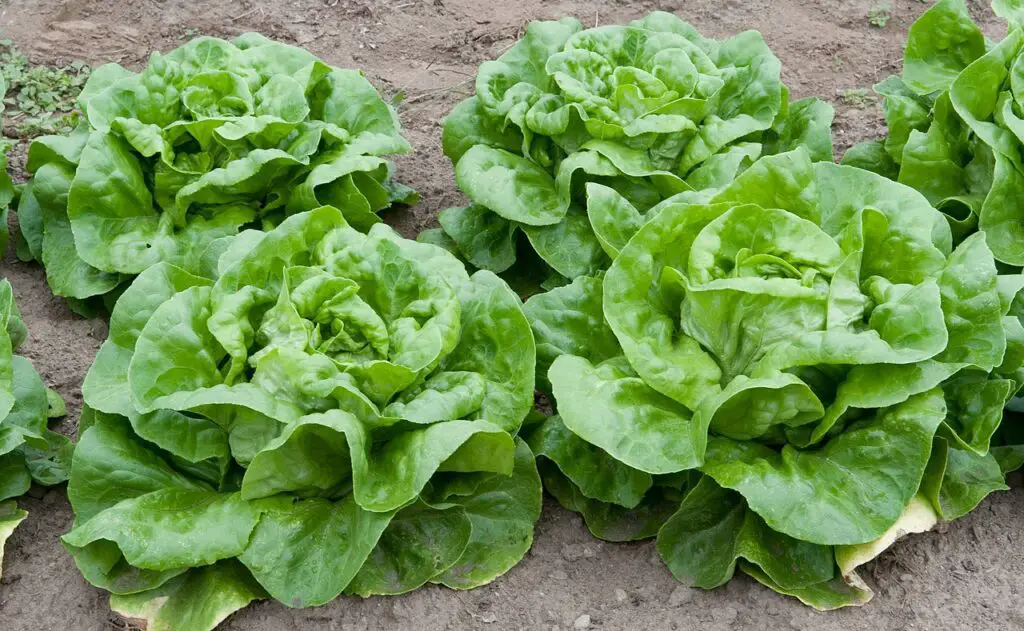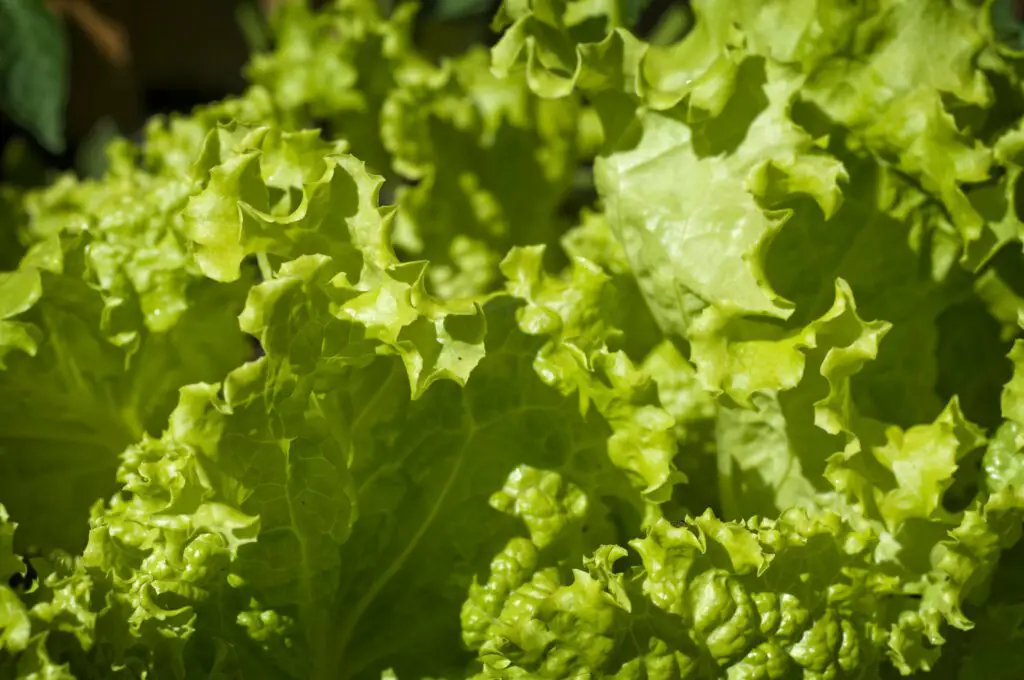As the saying goes, “You are what you eat.” This same principle applies to our beloved furry friends as well.
As pet owners, it is our responsibility to ensure that our dogs receive a healthy and balanced diet that meets their nutritional needs.
Many of us might be wondering if it is safe for our dogs to consume certain human foods, such as lettuce.
In this article, we will explore the potential benefits and risks of feeding your dog lettuce and provide some tips on how to safely incorporate this leafy green into their diet.
- Can Dogs Eat Lettuce?
- How Much Lettuce Can Dogs Eat?
- How Often Can Dogs Eat Lettuce
- Health Benefits of Lettuce To Dogs
- Potential Risks Of Feeding Lettuce To Dogs
- Nutritional Benefits of Lettuce For Dogs
- Are Dogs Sensitive To Lettuce?
- How To Prepare Lettuce For Dogs
- How Fast Will Dogs Digest Lettuce
- FAQs
- In Conclusion
Can Dogs Eat Lettuce?

Yes, dogs can eat lettuce safely and it can even have some benefits. Lettuce is low in calories and can be a great snack for your pup.
However, it’s important to remember that lettuce should only be offered in moderation and should not replace their regular diet.
Additionally, you should avoid giving your dog salads as they may contain ingredients that are not suitable for dogs.
It’s also important to note that different types of lettuce have different nutritional values.
For example, romaine lettuce is high in Vitamin A which helps with eye health and immune system function, while iceberg lettuce is mostly composed of water and provides little nutritional value.
Overall, lettuce can be a healthy treat for your pup if given in moderation. Just make sure to check the ingredients list on any salads you give them to ensure they don’t contain anything harmful or dangerous for dogs.
See also: 47 Safe Vegetables To Feed Your Dog. Puppy Power!
How Much Lettuce Can Dogs Eat?

It’s recommended to only offer your dog lettuce in small amounts as a treat or part of their meal, and not as a substitute for their regular food. Too much lettuce in their diet can cause digestive upset such as diarrhea or vomiting.
A general rule of thumb is to offer one to two small leaves of lettuce to smaller breeds, and a few more for larger breeds.
It’s important to introduce new foods slowly into your dog’s diet, particularly if they have a sensitive digestive system, in order to avoid any adverse reactions.
Always keep in mind that every dog is unique and may react differently to new food.
So, it’s a good idea to monitor your dog’s reaction when you introduce lettuce and consult with your veterinarian if you have any concerns regarding your dog’s diet.
Lettuce Feeding Chart According To Size
| Food | Size | Portion |
|---|---|---|
| Lettuce | Toy dogs | one to two leaves |
| Lettuce | Small dogs | one to two leaves |
| Lettuce | Medium dogs | three to five leaves |
| Lettuce | Large Dogs | three to five leaves |
Lettuce Feeding Chart According To Age
| Food | Age | Portion |
|---|---|---|
| Lettuce | 0 – 6 months | Don’t feed |
| Lettuce | 6 – 12 months | one to two leaves |
| Lettuce | 12 – 24 months | three to five leaves |
| Lettuce | 24+ months | three to five leaves |
How Often Can Dogs Eat Lettuce
While dogs can eat lettuce, it should not be a regular part of their diet. It’s safe to offer lettuce to your dog a few times a week or as an occasional treat.
This is because dogs have different nutrient requirements than humans do, so a diet based mostly on lettuce would be nutritionally inadequate for your dog’s health.
It’s also important to note that dogs have a different digestive system than humans, and they can’t break down certain food as easily.
Feeding your dog large amounts of lettuce or other vegetables frequently can cause them to have digestive problems such as vomiting, diarrhea, or gas.
In addition to providing the right amount of lettuce for your dog, it’s also crucial to ensure that it’s washed properly and free of any harmful chemicals or pesticides that could be toxic to them.
It’s always best to talk to your veterinarian about your pet’s specific nutritional requirements and how to incorporate lettuce into their diet properly.
Health Benefits of Lettuce To Dogs
- Low in calories. Lettuce is an ideal snack for dogs on a diet. It’s low in calories and high in fiber, which can help your furry friend feel full longer and prevent overeating.
- Loaded with vitamins. Different types of lettuce have different nutrient contents. For example, romaine lettuce is rich in vitamins A and C, which promote eye health and a strong immune system.
- Contains antioxidants. Lettuce is packed with antioxidants that help prevent and repair cell damage in your pet’s body.
- Good for digestion. The high fiber content in lettuce can aid digestion and prevent constipation in dogs.
- Can help with hydration. Lettuce is mostly composed of water, which makes it a great source of hydration for your dog on hot days.
- Freshens breath. Chewing on lettuce can help remove tartar buildup and freshen your dog’s breath.
Potential Risks Of Feeding Lettuce To Dogs
- Oxalates. Lettuce contains oxalates, which can cause kidney and bladder stones in dogs if consumed in large quantities over time.
- Digestive issues. Too much lettuce can cause gastrointestinal distress in dogs, leading to vomiting or diarrhea.
- Allergic reactions. Just like humans, some dogs may be allergic to lettuce. Symptoms of an allergic reaction can include itching, hives, and difficulty breathing.
- Romaine lettuce and E. Coli. Romaine lettuce has been linked to E. Coli contamination in recent years, and this bacterial infection can be dangerous for both humans and dogs.
- Salad dressings and toppings. Many types of salad dressing contain ingredients that are toxic to dogs, such as garlic, onions, and grapes. Toppings like nuts or raisins can also be dangerous.
- Choking hazards. Dogs may choke on large pieces of lettuce if they’re not cut up small enough for them to chew and swallow.
Nutritional Benefits of Lettuce For Dogs
| Lettuce Nutrition Facts per 100 grams | % DV * |
|---|---|
| Calories | 15 |
| Total Fat | 0.2 g |
| Cholesterol | 0 mg |
| Sugar | 0.8 g |
| Glycemic Index | 15 |
| Sodium | 28 mg |
| Carbs | 2.9 g |
| Protein | 1.4 g |
| Vitamin D | 0% |
| Calcium | 3% |
| Iron | 4% |
| Potassium | 194 mg |
Are Dogs Sensitive To Lettuce?
It is possible for dogs to be sensitive to lettuce, although it’s not a common allergy or sensitivity compared to some other foods. Symptoms of an adverse reaction can include:
- Vomiting
- Diarrhea
- Skin rashes
- Itching or swelling of the face, throat, or lips
- Loss of appetite
- Difficulty breathing
The severity and duration of these symptoms can vary depending on the individual dog and the amount of lettuce they consumed. If you notice any of these symptoms after giving lettuce to your dog, contact your veterinarian immediately.
It’s best to introduce new foods slowly and in small amounts to determine your dog’s tolerance level and whether they exhibit any allergic or sensitive reactions.
In general, some dogs may be more sensitive to certain types of lettuce, or to lettuce in general, so it’s always a good idea to keep an eye out for any adverse effects.
How To Prepare Lettuce For Dogs
Chopped up in small pieces
Dogs can have difficulty digesting large pieces of lettuce, so it’s best to chop it up into small, bite-sized pieces. This will also help prevent any choking hazards. You can mix the chopped lettuce into your dog’s food or offer it as a treat.
Blanched or steamed
If you’re concerned about your dog’s ability to digest raw lettuce, you can blanch or steam it to make it easier to digest. Simply add lettuce to boiling water for a few seconds, then remove with a slotted spoon and rinse under cold water to stop the cooking process. Once cooled, you can offer it to your dog as a snack.
Frozen as a refreshing treat
During hot weather, frozen lettuce can make a refreshing treat for your dog. Just chop the lettuce into small pieces and place them in a freezer-safe container. Once frozen, you can serve it to your dog as a healthy and hydrating snack.
How Fast Will Dogs Digest Lettuce
The speed at which dogs digest lettuce can vary depending on a number of factors, including their size, age, and overall health. In general, it takes about 8-10 hours for food to pass through a dog’s digestive system.
Lettuce is a low-calorie and high-fiber vegetable, which means it can aid digestion and promote regular bowel movements in dogs. The fiber in lettuce can also help regulate blood sugar levels and prevent constipation.
However, feeding your dog large quantities of lettuce or introducing it too quickly into their diet can lead to digestive upset such as diarrhea or vomiting. It’s best to introduce new foods slowly and in small amounts to avoid any potential digestive issues.
If you’re concerned about your dog’s digestion or if they exhibit any unusual symptoms after eating lettuce, it’s best to consult with your veterinarian.
FAQs
Can dogs eat lettuce leaves?
Yes, dogs can eat lettuce leaves! Lettuce is a great source of vitamins and minerals such as calcium, iron, magnesium, and zinc. It also contains fiber, which helps the digestive system.
Can dogs eat lettuce stems?
Yes, dogs can eat lettuce leaves. However, it is important to note that there are some types of lettuce that can be dangerous for your pup. Iceberg lettuce should not be given to dogs as it has a high water content and very little nutritional value.
Romaine and other darker-colored lettuces are generally considered safe for dogs, although they should be served in moderation.
In Conclusion
In conclusion, dogs can safely eat lettuce in moderation without any major health risks. Lettuce can offer dogs a low-calorie and high-fiber snack that can promote digestion and hydration.
Different types of lettuce have varying nutrient levels, with romaine lettuce being a more nutritious choice than iceberg lettuce.
However, lettuce should never replace your dog’s regular diet and should be given as a treat or complement to their meals.
It’s important to incorporate new foods slowly and in small amounts to avoid any digestive upset or potential allergic reactions.





Leave a Reply